Farman
|
1902
- 1930 |
Country: |
 |
|
Henry, Maurice and Richard "Dick" Farman
The name Farman is most associated with the military aeroplanes of the First World War and the commercial aircraft used on long-distance routes between the two World Wars. Although these machines were manufactured in France the three Farman brothers, Henry, Maurice and Richard (Dick), were of English, parentage. Henry was born in Cambrai in 1874 and Maurice in Paris in 1877.
The brothers became well-known, first as racing cyclists, and then as racing motorists, Henry winning the large car class in the Paris to Vienna Race in 1902 at the wheel of a
Panhard. The brothers owned the largest garage in Paris, the Palais de I'Automobile, and for a brief period around 1902 they manufactured the first Farman car - a 12 CV 2-cylinder model. However, this was not a commercial success and production soon ceased.
Farman Aeroplanes
In 1905 the Farmans became interested in the new science of aeronautics, and Henry won many prizes in competitions. The brothers established an aircraft factory at Billancourt which supplied flying machines to the French Army. These aeroplanes gained an excellent reputation during the First World War.
After the Allied victory, and the consequent reduction in orders for military aircraft, the factory had space to spare, and the Farman's decided to enter the luxury car market. It was their intention to build the best car in the world, and the design was entrusted to Charles Waseige, a staff engineer.
The A6A Farman
The A6A Farman made its debut at the 1919 Paris Salon. It was powered by a six-cylinder engine having a bore and stroke of 100 mm. x 140 mm., giving a cubic capacity of 6597cc. The steel cylinders had welded-on sheet-steel water jackets, while the overhead camshaft was driven by bevel gearings through an enclosed vertical shaft. The four-speed gearbox, the second- and third-speed pinions of which were cut with helical teeth for silent running, was mounted separately from the engine. Other features were a cone clutch, dual ignition, a crankshaft carried in three white metal-lined bearings, semi-elliptic
springs at the front and cantilevers at the rear. Brakes were on the rear wheels only, and there was also a
transmission brake.
The four-bladed fan was provided with a clutch operated by a lever on the dashboard, enabling the fan to be put out of action by the driver if the thermometer, also dashboard mounted, indicated that the temperature was becoming too cool for maximum efficiency. The wheelbase was 11 ft. 11 in. and the track 4 ft. 8 in. The engine developed 100 bhp at 2800 rpm. The RAC rating, used for UK taxation purposes from 1921 onwards, was 37.2 HP. The influence of aviation practice in the design of the luxury Farman was very marked. Extensive use was made of aluminium in order to reduce the weight. In addition to the touring, or standard, model, a sports model was also offered, the maximum speeds claimed being 70 mph and 90 mph respectively.
Perrot System Brakes
Basically, the same model was offered throughout the twelve-year life span of the company's car division, various modifications being incorporated during this period. In 1921 the gearbox became united with the
engine, a multiple disc clutch replaced the cone clutch, and four-wheel
brakes based on the Perrot system became available, the model now being designated the A6B. After 1924 the sports version appears to have been dropped from the range. The NF Farman, superseding the A6B, made its debut at the Paris Salon in 1926, powered by a slightly larger engine with a bore and stroke of 100 x 150 mm., giving a capacity of 7071cc.
The cylinder block was of aluminium alloy (Alpax), following the practice adopted on the later A6B cars. Other important modifications were the duplex
steering gear and the so-called "Compound"
suspension. The new
steering gear was designed to overcome the problem of wheel wobble ("shimmy"). The tie-rod was sprung with the chassis, coupling it to the
steering arms at each end by short rods universally jointed, large radius rods being fitted to maintain the alignment of the front axle. It was claimed that the bursting of a tyre, even at speed, did not affect the steering wheel.
 1919 37.2 hp Farman with wire wheels.
1919 37.2 hp Farman with wire wheels.
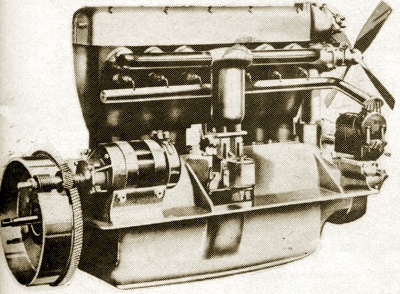 Even by today's standards, this engine would be considered neat. It is the engine from the 37.2hp Farman (pictured at the bottom of this article).
Even by today's standards, this engine would be considered neat. It is the engine from the 37.2hp Farman (pictured at the bottom of this article).
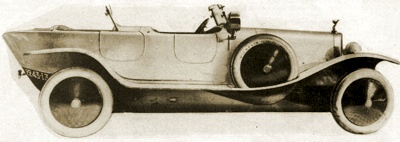 1924 Farman Boat Tail.
1924 Farman Boat Tail.
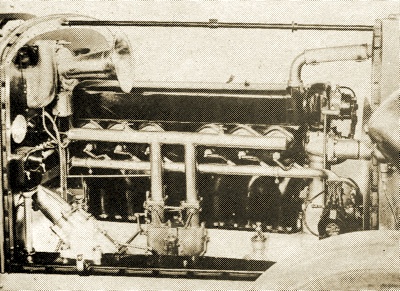 Six-Cylinder Farman Engine.
Six-Cylinder Farman Engine.
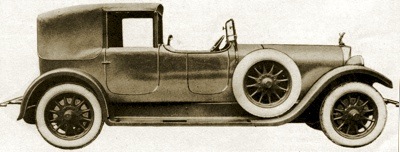 1926 Farman Limousine.
1926 Farman Limousine.
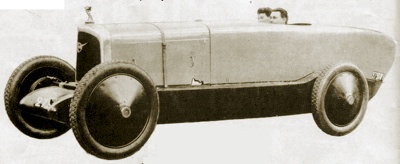 1923 Farman Streamliner which used aeroplane design techniques.
1923 Farman Streamliner which used aeroplane design techniques.
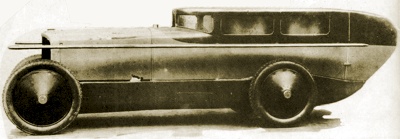 Farman Streamliner Boat-tail. The mudguards were hinged to allow access.
Farman Streamliner Boat-tail. The mudguards were hinged to allow access. |
Compound Suspension
The "Compound"
suspension consisted of a broad transverse spring in the front, supplemented by a pair of cantilever springs, while, at the rear, full cantilevers with a transverse spring, and a special stabiliser to prevent rolling were employed. Houdaille shock absorbers were standard equipment. Two lengths of chassis were available, the long-chassis version being known as the NF2; it is probable that NF signifies "Nouvelle Farman". In 1929 the Farman's distinctive, if rather ugly, V-radiator was replaced by a flat radiator, giving the car a pronounced transatlantic appearance and lessening the marque's individuality.
Farmans appeared at the London Motor Shows (either at Olympia or the White City) from 1919 to 1926, with the exception of 1922, and a polished chassis or engine was always featured on the stand. Coachwork of outstanding merit was also on display, ranging from rakish Grand Sport tourers to the ultimate in luxury limousines. H. & M. Farman were somewhat unusual among top-ranking car manufacturers in having their own coach building department, and a number of the cars on view had factory-built bodies. However, the work of world-renowned connoisseurs such as Barker, H. J. Mulliner, Windovers and Million-Guiet was also happily demonstrated on the Farman chassis.
More Expensive Than A Roller
At the 1919 Olympia Motor Show the price of the chassis was quoted at £1900, compared with £1575 asked for the Rolls-Royce Silver Ghost. In 1920 Farman raised their price to £2360, making it the most expensive chassis in the Show. In later years the figure fell to £1200 and the average price for a limousine was around £2000. Needless to say, the motoring magazines in this country as well as in France were anxious to test the Farman when it made its debut, but they had to wait awhile, for serious production does not seem to have started before 1921. In 1922 an A6A Type Sport tourer was given a road test by La Vie Automobile, which, by the standards of the vintage era, was surprisingly thorough.
This sports model was fitted with two carburettors and the timed maximum speed was 90 mph - a figure little short of astounding for the period. This speed was attained with four up on the road between Chartres and Chateaudun. The magazine declared that, among all the cars that had passed through its hands, the Farman came the nearest to perfection - it was a car of great luxury and yet a sports car. In 1923 it was the turn of the British motoring press to take the wheel of a Farman, The Motor publishing its impressions of the A6B touring model fitted with a French-built 4-seater torpedo body. The British journalists were not able to make an extensive test of the car, but they spoke highly of the flexibility and silence of the power unit, and the acceleration in top gear.
A speed of 70 mph was attained, the throttle not being fully open. The springing was praised; on bumpy roads it imparted the impression of floating on air, although there was a tendency to roll on corners. In summing up. The Motor found itself at one with its French contemporary in declaring " ... it would not be exaggerating in the slightest to say that it is one of the finest touring cars in which we have ridden."
La Vie Automobile
In 1926 La Vie Automobile tested a standard model A6B cabriolet. The engine was equipped with the new aluminium alloy cylinder block, but not the duplex steering and "Compound" suspension which were to appear at the Paris Salon later in the same year. The maximum speed with six up was 75 mph. The car was found to be very silent, with no vibration up to 68 mph and the magazine's tester, Henri Petit, described the springing as truly perfect. There is little doubt that the motoring press in the UK and in France treated the Farman in a manner akin to reverence. The Motor wrote that although it ranked as a luxury super-car it was by no means a chauffeur's car; it would appeal to the owner-driver who must have the best at his command.
The Farman was lauded as a car turned out regardless of expense for the fortunate few. Yet the Farman was not a commercial success, only some 120 examples being made from 1919 to 1931, when the world depression caused the company to cease production of these majestic automobiles. Not more than a half-dozen are believed to have been sold in the UK, and the make did not appear in British buyers' guides after 1927. It did remain available in France, but made its final appearance at the Paris Salon in 1930.
In the late nineteen-thirties plans were made to revive the car division, the new model to be powered by a V8 engine, but these efforts fell short. The A6A Farman made its debut at the same time as the
H6 Hispano-Suiza - another firm with a successful aviation history behind it. though as
engine manufacturers, whereas the Farman brothers constructed fuselages. The dimensions of the six-cylinder
engines fitted to these two marques were identical, i.e. 100 bore x 140 mm. stroke, and were to be adopted by
W. O. Bentley six years later with his 6.5 litre. However, the Farman lacked the performance and controllability of the
Hispano, the duplex
steering proving too heavy; from the standpoint of the enthusiast the car was too much like a lorry in its handling.
French Cars from 1920 to 1925
In his book "French Cars from 1920 to 1925" Pierre Dumont pondered whether the failure of the Farman to match the
Hispano in public esteem may have been due to the car's large and ungainly radiator, which discouraged coachbuilders from emulating the attractive bodies mounted on the rival chassis, but he thought it more likely that certain mechanical shortcomings accounted for the car's lack of commercial success. It was reported that the Alpax cylinder blocks, when first fitted, were not watertight, and that the big-ends proved vulnerable under high-speed cruising.
W. F. Bradley, Continental correspondent of The Autocar during the vintage years, once wrote that French designers cherish an innate love for a mechanical masterpiece, and not infrequently they have allowed this love to overrule commercial dictates. Perhaps this charge could have been levelled against Charles Waseige, whose designs were nothing if not complex, and consequently costly. It was only the wealthiest motorists who could even consider the purchase of a Farman, and such motorists as a class were innately conservative and suspicious of innovation. Herein lies another reason for the Farman's failure to win their custom.
The French Rolls
However, the make had at least one highly satisfied customer. In 1929 the correspondence columns of The Motor featured a debate on the subject of the world's best cars. One reader included the Farman in his selection, which prompted a correspondent, writing from Eastbourne over the nom de plume of "Spaniard", to pay a glowing tribute to the marque. His family had the latest model, which, he claimed, was the only French car capable of beating the American eight-cylinder cars in silence and top gear performance. The
steering lock was phenomenal and the
steering and springing on the pot-holed pave of French roads had to be experienced in order to be fully appreciated. The writer pointed out that the car had a five-year guarantee, and he concluded his letter by making the claim "This new model is the French Rolls".
The Perils of Pauline
The Farman was certainly not short on glamour and some beautiful bodies were constructed on the chassis. The Shah of Iran was driven in a coupe de ville with coachwork by Jean Gaborit, and the Sultan of Morocco rode in a magnificent torpedo, the rear compartment of which was fitted with a separate windscreen. The American film actress Pearl White, star of the serial "The Perils of Pauline", owned a coupe de ville, while Charles Nungesser, French air ace of the First World War, had a Grand Sport tourer. Nungesser, and his co-pilot Frangois Coli, lost their lives in 1927 when attempting to make the first east-west crossing of the Atlantic Ocean in an aeroplane. That aircraft was not a Farman.
La Conquete de I'Air
The marque's mascot, introduced in 1922, was a large figure of Icarus called "La Conquete de I'Air", being a reproduction of a sculpture by Colin George commemorating the first winged flight of Santos-Dumont. The advertising slogan of the company was "Une
automobile route, la Farman glisse ..." (A car rolls, the Farman glides . . .). The make did not cover itself with glory in sporting events. A Farman took part in the Circuit des Routes Pavees in 1922 without setting the Seine on fire, while in 1923 two specially built streamlined lightweight cars, one open and the other closed, were entered for the Nice Speed Trials. It is not clear if, in fact,they participated in these trials or, indeed, in any competitive activities.
The Farman seems to have been a rather glorious failure. Every enthusiast admired it, and the motoring press was full of praise for the brilliance of its engineering, but very, very few people were prepared to buy it. Henry Farman died in
1958 and Maurice Farman in
1964. Henry lived in France all his life but did not adopt French nationality until 1937. He became a Commander of the Legion of Honour, the order founded by Napoleon. Rather strangely, his entry in Who's Who, worded by himself, made no mention of his activities as a manufacturer of luxury cars. Maybe this was because his cars failed to match the esteem earned by his aircraft.



